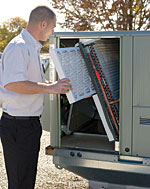Proper filter maintenance is crucial to keeping HVAC ductwork clean. If dirt accumulates in the ductwork, and if the relative humidity reaches the dew point and condensation occurs, ductwork can become a breeding ground for bacteria and mold. This is especially the case in HVAC systems that are prone to mold growth, such as those with acoustical duct liners.
For all of these reasons and more, it is imperative to establish the appropriate filter change out frequency. In addition, filters should be changed immediately if they become wet, if microbial growth on the filter media is visible, or when the filters collapse or become damaged to the extent that air bypasses the media.

FILTER INSTALLATION
It's critical to pay close attention to proper filter installation. The goal is to avoid bypass air, which causes contamination in housings, coils, fans, and ducts.For high-pressure-drop filters, small gaps around the filter or filter housing can decrease filter performance. Large gaps can substantially decrease filter performance. A 1-mm gap, for instance, can create bypass flows that may be up to 5 percent of the total flow. For a 10-mm gap (slightly larger than the diameter of a pencil), bypass flows can increase 25 percent to 35 percent of the total flow. Because higher-efficiency filters also typically have a larger pressure drop, bypass air tends to have a larger effect on high-performance filters.
The net result of bypass air is a reduction in the Minimum Efficiency Reporting Value (MERV), a filter rating system based on the filter's ability to remove airborne particles of different sizes. For example, research models have shown that a 1-mm gap causes a MERV 15 filter to perform like a MERV 14 filter. A 10-mm gap results in the MERV 15 filter performing like a MERV 8 filter.
The best way to avoid bypass air is to make sure that all the air in the system goes through the filter. To avoid problems later on, the maintenance provider should:

FILTER MONITORING
After filters are installed and operating, they should be monitored and maintained to provide maximum filtration without overtaxing the supply fan capability, which can lead to blowout situations with no air filtration. Scheduled maintenance or established pressure drops can help determine when filters need to be changed, along with specific variations in environmental conditions, such as humidity and seasonal changes.To use the pressure drop method in a commercial building with several filters and a building automation system (BAS), install a differential pressure measurement device across the filter bank. Pressure drop switches may be used to provide an alarm input to the BAS, which then alerts building operators to change the filter. Don't rely on a visual inspection alone; medium- and high-efficiency filters that appear dirty often have not reached their optimum efficiency levels due to depth loading. In fact, filters should appear dirty. This is a good indication they are doing their job.
As a filter loads up with particles, it becomes more efficient at particle removal. However, it also increases pressure drop through the system, thus reducing airflow while consuming more energy.
All filters, if loaded to excess, will become deformed, will unload dust, and even blow out of their filter rack. When filters blow out, the bypass of unfiltered air will lead to clogged coils and dirty air ducts. Flow capabilities of the system fan may also be affected.
Filters should be monitored for bacterial growth too. It's a good idea to remove selected filter elements periodically and send them to a lab for testing if bacterial growth is seen.
KEEP THE JOB EASY
Keep the following tips in mind to help keep filter replacement easier and better organized:

PROTECT THE SYSTEM AND OCCUPANTS
If schedules allow, time filter change outs so that they occur when the facility is unoccupied. This will help to prevent problems associated with disruptions in the HVAC system's operation, and possible distribution of particles that may occur when dust-loaded filters are disturbed.In some facilities, it's nearly impossible to time filter change outs so that they occur when the facility is unoccupied. In that case, turn off the supply fans to prevent debris from entering the ductwork downstream of the filters.
In fact, the entire filter area should be cleaned and washed down while fans are off. Use a clean rag instead of compressed air and wipe dust from the inside of the filter housing and around gasket surfaces. When removing a used filter, take care to avoid dropping contaminants in the ductwork.
At the end of the day, it is important to follow the recommendations of the filter manufacturer to determine the proper procedures and frequencies for maintaining and changing filters. Don't forget to fully document all inspections and corrective actions.
For more information on HVAC filter installation and maintenance, the National Air Filtration Association (NAFA) offers several resources, including The Installation, Operation, and Maintenance of Air Filtration Systems (2nd Edition), the NAFA Guide to Air Filtration, and the NAFA Certified Technician (NCT) Program, which is available to service companies and in-house HVAC professionals.
Dave Matela is a Certified Air Filtration Specialist (CAFS) through the National Air Filtration Association, and market manager of Kimberly-Clark Filtration Products (www.kcfiltration.com).
Sidebar: Check the Details
When changing a filter, make sure that the replacement filter is of the correct size and compatible with the housing. Review the performance value of the filter to ensure the pressure drop across the filter will not be too great, especially as the filter loads. The greater resistance will reduce airflow to the HVAC unit, creating a negative impact on the unit's heating-cooling ability and energy efficiency.Publication date: 04/24/2006

Report Abusive Comment